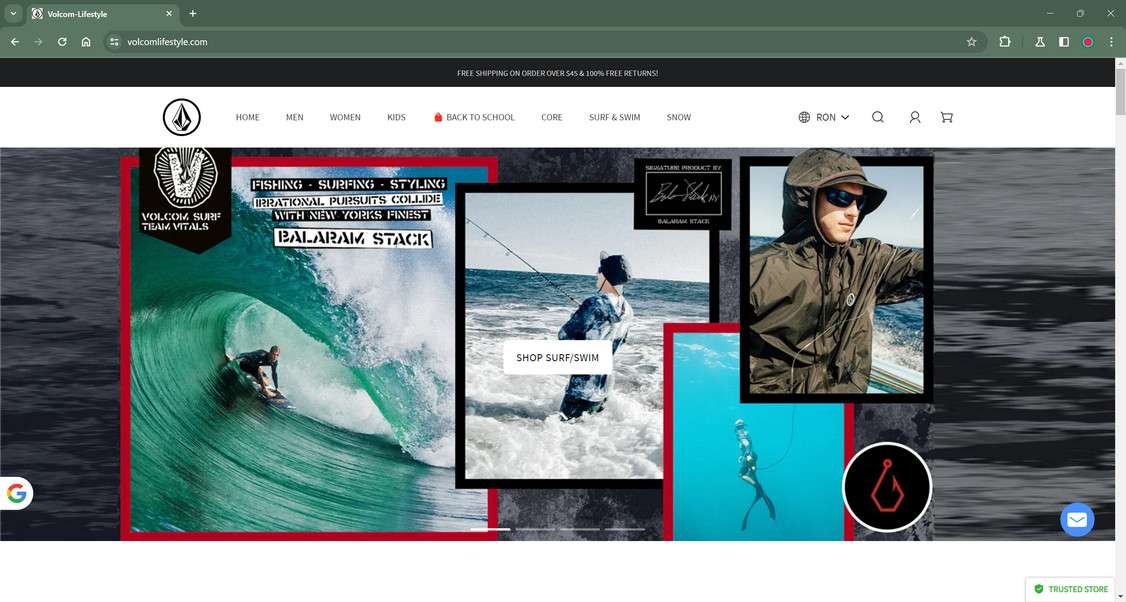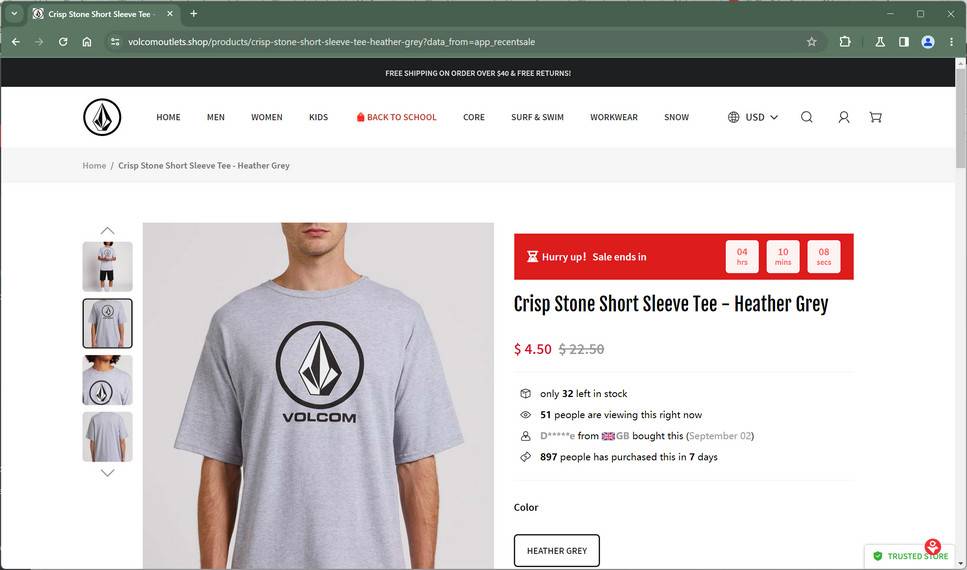Over the last few months, ads promoting incredible Volcom clothing deals up to 90% off have exploded across social media. But before you jump on these bargains, be warned – this sought-after sale is a sophisticated scam designed to trick unsuspecting shoppers.
This in-depth article will reveal how the Volcom clearance sale scam ensnares victims, tactics for avoiding it, and steps to take if you fear you’ve been swindled.





This Article Contains:
Overview of the Volcom Clearance Sale Scam
Volcom is a popular surf/skate/snowboard lifestyle brand known for its edgy clothing, accessories and gear. However, the company has no affiliation with any online sales promising Volcom products at steeply discounted prices.
The Volcom clearance sale scam works like this:
Fraudsters create fake e-commerce websites designed to mimic the real Volcom site and run paid ads driving traffic to them. The ads tout a seasonal Volcom “Warehouse Sale” or “Going Out of Business Clearance” with items slashed up to 90% off.
When users click through to the site, they are met with a polished storefront filled with Volcom merchandise marked down to tempting prices like $39, $49 or $59. Believing the legitimacy of the sale, shoppers hastily purchase products.
However, afterwards buyers experience the bait and switch. They either receive:
- Subpar quality items
- Completely wrong, random products
- No delivery at all
Any attempts to contact Volcom customer service go unanswered, since all the contact info is fabricated. Shortly after launching, the fake sites vanish without a trace, deleting any evidence for authorities.
So why does this brazen scam manage to repeatedly dupe savvy shoppers? Some key psychological triggers are at play:
- FOMO – The ads portray a limited-time flash sale, creating fear of missing out on the deals. This pressures shoppers to buy quickly before time runs out.
- Social proof – Fake customer reviews and ratings on the sites establish a false sense of credibility and trust.
- Reciprocity – After entering payment info, some sites offer additional % off items. This activates feelings of obligation to complete the purchase.
- Deal appeal – Volcom’s streetwise image makes the idea of scoring cut-rate wares highly appealing. Shoppers get so focused on the deals they overlook red flags.
- Low prices – Odd prices like $29 instead of $30 seem like authentic markdowns rather than calculated marketing ploys.
By exploiting Volcom’s brand reputation for scoring sweet deals, the scammers bank on duping shoppers blinded by the prospect of cheap prices. Their slick operation convinces even savvy shoppers – until it’s too late.
This scam proliferates across platforms like Facebook, Instagram, YouTube, and TikTok using paid ads and influencer promos. Countless users fall prey daily, lured in by the promise of discounted Volcom threads.
How the Volcom Clearance Sale Scam Operates
The criminals running this fraud put great effort into making their fake Volcom websites look authentic from top to bottom. Here’s an in-depth look at how the rip-off works at each step:
1. Eye-Catching Social Media Ads Promote the “Sale”
On platforms like Instagram or while browsing online, flashy video and display ads pop up promoting a special Volcom warehouse clearance event. The ads tout “up to 90% off” limited-time savings on Volcom apparel and gear.
To create urgency, they use slogans like “Today Only!”, “Limited Quantities” and “Going Out of Business Sale”. After seeing celebrities and influencers hyping the discounts, shoppers get hooked.
2. Fake Ecommerce Sites Mimic the Real Volcom.com
Clicking the ads leads shoppers to sites designed to look exactly like the real Volcom website. The logo, branding, product catalog, and overall aesthetic are stolen directly from Volcom.com to appear authentic.
Some even have fake customer reviews, an “About Us” page detailing Volcom’s history, and other legitimacy markers. Unless scrutinized carefully, it’s tough to discern the sites as imposters.
3. “Discounted” Items Lure Shoppers
Upon entering the site, users see racks and stacks of Volcom shirts, hats, hoodies, and accessories seemingly discounted up to 90% off. For example, a $60 t-shirt now only $6.
Countdown timers, limited stock warnings, and too-good-to-pass-up prices prod shoppers to hastily add items to their cart and check out before the deals vanish.
4. Customers Buy Products Under False Pretenses
With such deep discounts, buyers are convinced the sale is 100% authentic. No need to question whether Volcom would actually clear out inventory this cheaply.
After eagerly inputting payment and personal information, purchasers only later realize the scam.
5. Buyers Receive Inferior or Unordered Products
Weeks after an order is placed, customers either get:
- Cheap knockoffs – items sporting blurry, misshaped Volcom logos and poor quality
- Random wrong products – sunglasses instead of sweatshirts, baby toys instead of hats
- Nothing at all – zero delivery after weeks of waiting
Flooded with complaints, the fake sites quickly disappear. But by this point, it’s too late – the damage is done.
6. Scammers Resurface Under New Domains
A key scam component is that these fake Volcom sites frequently vanish and pop back up under fresh domain names. This prevents authorities from tracking them down.
The endless reincarnations of the ploy trick Volcom fans over and over. Only through education can consumers avoid falling victim when new sites inevitably emerge.
How to Identify Fake Volcom Websites and Avoid the Scam
When evaluating potential Volcom deals online, there are several tell-tale signs indicating a website is fraudulent:
1. Check the Domain History and Registration
Use tools like WhoIs domain lookup to research when the site’s domain was registered and location details. Fake sites often have domains created very recently and use privacy services to hide ownership info. For example, volcom-clearancesale.com was registered 1 month ago in Iceland – highly suspicious.
2. Look for Missing Contact Information
Authentic retailers always provide telephone numbers, physical addresses, and contact forms to assist customers. Scam sites will often only have an email address buried at the bottom – and it may be an address from a shady domain. No real world coordinates are a red flag.
3. Inspect Product Photos Closely
Scammers steal product images directly from authentic sites like Volcom.com. But differences reveal their lack of genuine items. Look for fuzzy logos, watermarks in other languages, weird backgrounds, and identical shots used on other scam sites.
4. Assess the Pricing for Realism
Fake sites tout discounts up to 90% off MSRP prices on all Volcom items. These are unrealistic clearance prices – even for last season’s gear. Volcom would never offer $500 jacket for $50. Also look for uneven, odd pricing like $33 instead of rounding to $30.
5. Read the Site Copy for Errors
Counterfeit sites often contain typos, bad grammar, and other textual errors that legitimate brands would not have. Look out for things like “Limted Time Only!” or products titled “Mens Teeshirt”.
6. Watch for High-Pressure Tactics
Fake sites push exaggerated urgency with countdown timers, limited quantity claims, and messaging insisting the jaw-dropping deals won’t last. This pressures customers to purchase without rational consideration.
7. See If Images Are Traced Back to Other Scams
Do a reverse image search on the product photos. Chances are the same stock images appear on numerous other scam sites by the same operators selling everything from Rolexes to Ray-Bans.
Stay vigilant looking for these warning signs, and trust your instincts if a site just doesn’t feel credible. Make sure to verify site legitimacy through independent research before supplying any personal or payment information. Outsmarting these fraudsters starts with awareness and proactive scrutiny.
How to Identify the Volcom Scam on Social Media
How to Identify the Volcom Scam on Facebook
Look for Sponsored Posts
The scam ads on Facebook are usually sponsored posts in your feed using eye-catching video and imagery of Volcom apparel with 90% off slogans. Be skeptical of any sponsored posts pushing special clearance or warehouse events.
Scrutinize Ad Copy
Read the ad copy closely. Scams ads use enticing language like “Blowout Sale – Today Only!” or “Massive Warehouse Liquidation”. They create falsely urgent calls-to-action encouraging users to click through immediately before the deals expire.
Visit Page Transparency
Click the “Page Transparency” option on the ad and look for any transparency violations which indicate scams. Many use fake accounts and change page names frequently once exposed.
Reverse Image Search
If product images seem too good to be true, do a reverse image search using Google. Chances are the pictures are stolen from other sites, confirming their lack of genuine merchandise.
How to Spot the Volcom Instagram Scam
Look for Influencer Promos
Scammers pay or incentivize influencers to promote the fake sales on Instagram and TikTok. Be skeptical of any influencer posts flaunting unbelievable Volcom deals.
Check Comment Warnings
Scan the comments on sponsored posts – you’ll often see users warning about the scam or sharing their bad experiences. Comments help expose frauds.
Look for Reposts of the Same Ad
Scam ads get recycled frequently across bought or hacked Instagram accounts. Notice if the exact same video ad or post crops up from different accounts – major red flag.
Assess Account Legitimacy
Click on the account running the ad and look for signs of inauthenticity like zero posts, no profile photo, or engagement only on scammy giveaways. Real brands have robust feeds and interactions.
Recognizing Volcom TikTok Scams
Look for Brand Hijacking
Watch for accounts using Volcom’s name and logos but zero affiliation with the company. Scammers create accounts to appear official.
Reverse Image Search
If you see TikTok ads or posts showcasing steep Volcom discounts, reverse image search the product photos. Just like Instagram, chances are the images are copied from authentic sites.
Assess Follower Count
Fake accounts promoting scams often have abnormally low or inflated follower counts. Authentic brand accounts have follower bases growing steadily over time.
Check for Negative Comments
Real scam TikTok posts get flooded with warnings from those who got duped. Check comment sections for users sharing their negative experiences.
Stay vigilant for these tell-tale scam signs on social platforms. And when in doubt, go directly to the official Volcom website for any sales or promotions.
What to Do if You’re a Victim of the Volcom Sale Scam
If you suspect you’ve been hoodwinked by a fake Volcom website promising steep discounts, here are crucial next steps:
1. Act Fast to Increase Odds of Recovering Losses
Every moment counts when dealing with purchase scams. Immediately call your credit card provider to report the charges as fraudulent. Provide documentation showing how the site misrepresented its products and brand. Quick action raises your chances of successfully disputing the charges.
2. Gather All Relevant Records
Collecting evidence is key for getting refunds or enforcing fraud claims. Save the website pages, product photos, and confirmation emails. Screenshot payment receipts and shipping details. Photograph any items received. Records substantiate your experience.
3. File Complaints With Relevant Authorities
Another avenue for recouping losses is reporting the scam to consumer protection groups. File claims with the FTC, state attorney general, and organizations like Europol. While not immediate relief, it helps authorities track down scammers eventually.
4. Leave Online Reviews Warning Others
Post your Volcom scam experience on review sites like Trustpilot and Twitter. Write blog posts describing the fraud on websites like RipoffReport.com. This helps other consumers bypass the pitfalls and fuels efforts to shut down the scammers.
5. Learn to Identify Warning Signs
Reflect on what red flags you overlooked so it doesn’t happen again. Bookmark authoritative scam education sources like BBB.org that keep you informed as new online scams emerge. Remaining vigilant is the best way to sidestep future fraud.
Frequently Asked Questions About the Fake Volcom Sale Scam
1. Are the Volcom 90% off sales promoted on social media real?
No. Any online offers or websites promoting Volcom products at steep discounts of 90% off or more are outright scams trying to defraud customers. Volcom is not affiliated with these fake sales.
2. How can I tell if a Volcom sale website is a scam?
Warning signs of a fake Volcom website include prices too heavily discounted, recently registered domains, only an email address for contact, and social media ads using FOMO tactics.
3. What happens if I purchase from a fake Volcom website?
You either won’t receive anything, get a low-quality counterfeit item, or receive a random product you didn’t order. Your payment info is also now compromised along with any other personal data collected.
4. What should I do if I bought from a scam Volcom website?
Act quickly to report fraudulent charges to your bank or payment provider. Gather evidence and file complaints with the FTC and state attorney general. Check the FAQ section above for more advice on recovering losses.
5. How can I get real deals on Volcom products?
Go directly to Volcom’s official website or authorized retailers like Zumiez and Tilly’s for any sales or discounts. Check Groupon and social media for Volcom coupon codes. Avoid shady sites touting unrealistic markdowns.
6. How do these Volcom scam websites keep getting away with fraud?
The fake sites disappear quickly after collecting victims’ money and pop back up under new domains. This ephemeral nature makes it hard for authorities to track the scammers. They also leverage social media ads and influencers to give the scam an air of legitimacy.
7. Why does Volcom appeal to scammers for fake sales?
Volcom’s reputation for edgy streetwear and action sports gives scammers mass appeal to promote fake discounts. The brand’s anti-establishment image also downplays skepticism of “too good to be true” deals.
8. How can I report a fake Volcom website to help stop the scam?
Use scam reporting sites like WhoIsHostingThis.com to get fraudulent sites shut down faster. You can also report scam posts directly on the social platforms they appear on. Spreading awareness about the scam helps cut down on new victims.
9. How can I avoid falling for online shopping scams in the future?
Be wary of unbelievable deals, newly created domains, fake influencer endorsements, and pressure tactics on social ads. Vet sites thoroughly before purchasing. Check scam educational resources like BBB.org to stay informed about the latest rip-offs.
10. What measures is Volcom taking against these scams?
Volcom diligently works with authorities to get fraudulent websites taken down through cease and desist letters. They also issue scam warnings on their official social media channels to educate consumers. But staying vigilant is the best defense against clearance sale scams.
The Bottom Line: Avoiding the Volcom 90% Off Scam
The promise of scoring drastically discounted Volcom gear is certainly alluring. But exercising caution with online sales prevents you from getting burned by such counterfeit offers.
Here are the hallmarks of a fake Volcom website scam to recognize:
- Unbelievable discounts over 90% off retail price
- High-pressure tactics like limited time offers
- Newly registered domain and general lack of online history
- No customer service contact number or address
- Reviews seem overly positive or fake
- Missing or incorrect contact and policies pages
- Broken links, misspellings, or site glitches
If a website promoting steep Volcom discounts raises any red flags, avoid supplying payment or personal information. Do your homework vetting sites before purchasing. Search the domain registration records and run it through scam-detector sites like ScamAdviser.
Stay vigilant – and spread awareness about these Volcom fashion scams to help protect fellow enthusiasts. Shop smart and don’t let the lure of deals overshadow sound judgment.










